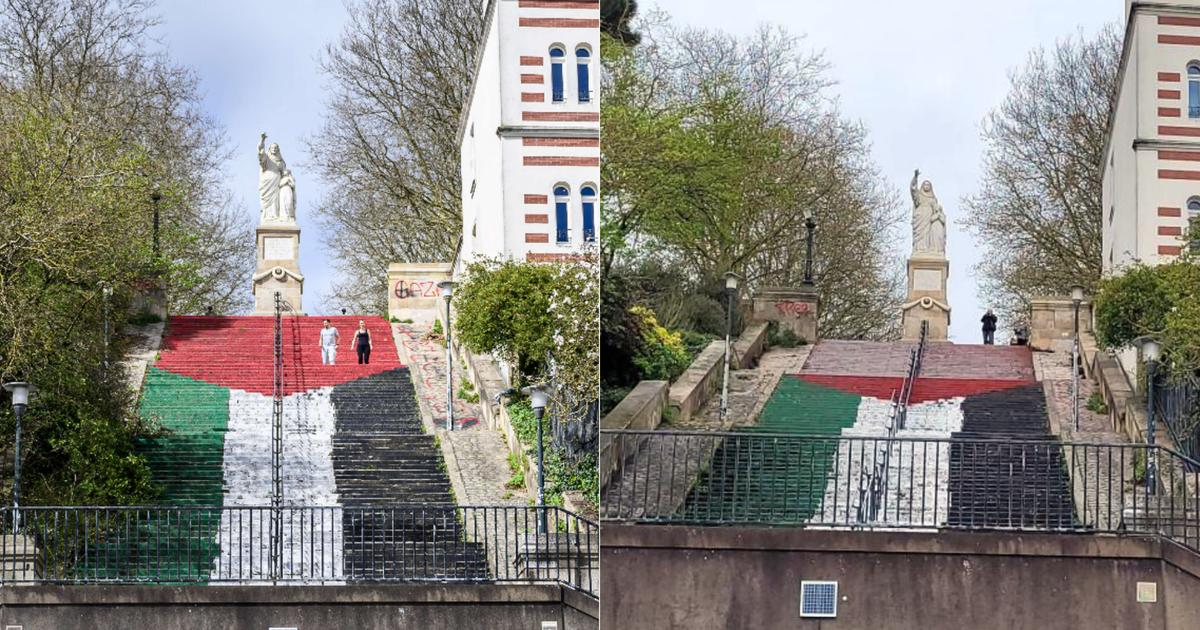Brian E. has dressed up. The 27-year-old, a well-trained giant with beard and bald head, wears a dark blue suit and elegant shoes. As he stands there with a serious look and a crushed back, he could get through as the CEO of a hip tech startup.
But Brian E. is not in his office and is not an entrepreneur. In Hall 14 of the Leipzig Regional Court, he appears on this frosty day at the end of November as a defendant: It is the second trial day in one of the so-called Connewitz trials.
The left-alternative district in the south of Leipzig was the scene of a raid-like violence in January 2016: right-wing rioters, armed with truncheons and wooden slats, devastated a whole street within minutes (read more about the "Sturm auf Connewitz").
Five police officers and at least one local resident suffered injuries, the material damage estimated the investigators to about 113,000 euros. The mayor later spoke of "open street terror", a police officer of scenes "as in a war zone".
Since August 2018, more than 200 alleged violent perpetrators have been answerable to various courts for breaches of the peace by the people - Brian E. is one of them. Leipzig District Court had sentenced him to 16 months probation last year.
The current appeal against him is about more than an isolated case. It is also about the handling of the rule of law with the right-wing in its own ranks. Because Brian E., born in 1992 near Dresden, is not some defendant: The lawyer completed as a junior lawyer his preparation service at the district court Chemnitz - which raises the question of whether a suspected rightwing violent perpetrators can be part of the judiciary.
In July, colleagues from E. E. had appealed to the Dresden Higher Regional Court (Oberlandesgericht) responsible for education and made public their concern about the case: Every trainee, according to media reports in the letter, had to plead her constitutional loyalty.
Pyrotechnics, lighters, an ax
The letter raised an important question: How should the judiciary deal with employees who appear to sympathize with anti-government or anti-democratic ideas? And how far does the right of judicial employees to free personal development and political will formation?
The matter is tricky, even for the defendant. Should it stay with him for more than a year in prison, this would mean the end of his judicial career: E. could then be excluded from the public service because of doubts about the constitutional fidelity. That is probably why he appealed.
In November 2020, the legal clerkship would end on schedule, in a break from negotiations E says: "I want to do the second state examination and then you have to see what else is possible." The fact that he is approaching this goal, without being legally convicted, is also due to the fact that the beginning of the appeal process had to be postponed several times: E. had twice reported sick.
Before the district court, among other things, the question of what happened exactly on January 11, almost three years ago in the south of Leipzig: On the second day of the trial, Gabriela Walburg reads out testimony, in which of blows and scratches on cars and smashed windows the Speech is. Also photos of the crime scene shows the chairman: pyrotechnics can be seen on this, lighters, an ax.
The chaos of Connewitz
Scene of the crime Wolfgang-Heinze-Straße, Leipzig: In the left-alternative district, a right-wing mob raged on 11 January 2016.
The perpetrators, who are said to have been almost all masked, destroyed dozens of window and shop windows within a few minutes. Many were also armed: with axes, iron bars and wooden slats.
In the summer of 2018, the processing of the trial of violence began in court. The investigators had previously identified a total of 216 suspects, they were still fixed on the evening of the riots.
Most of the accused were indicted in Leipzig district court. 92 trials were scheduled there, for the first six judges needed more than four months.
The extent of the violence was enormous: the rioters dented small cars, fired pyrotechnics, smashed the windows of bike shops, cold frames and hair salons. At least six people suffered injuries.
In the first Connewitz trial, the district court sentenced two defendants in August 2018 to one year and eight months in prison - without parole.
In the following processes there were in many cases probation sentences after a so-called Deal: The defendants made a confession and received for this a previously negotiated penalty frame promised.
A craftsman fixes in January 2016 damage to a broken window in Connewitz: The total physical damage estimated the prosecutor's office at about 113,000 euros.
District Judge Marcus Pirk was responsible for several of the Conewitz proceedings, which can not be avoided according to the court spokesman also: At the district court Leipzig work only 39 professional judges in two criminal departments.
In the trials eyewitnesses spoke impressively about devastation and injuries. A comprehensive explanation of the organizational structures behind the riots may not be possible for the judiciary.
The rioters had apparently exploited the fact that many residents of Connewitz participated in a major counter-event on the sidelines of a demonstration of the racist "Legida" alliance.
The police took more than 200 suspects into custody; Five officers were injured, and a roof came on fire. Leipzig Mayor Burkhard Jung described the violence excesses as "street terror".
For example, a snack was badly devastated. "That was no longer a shop," he said in late November 2019 as a witness in a trial before the Leipzig district court. The damage amounted to more than 20,000 euros.
The district court also negotiated the case of accused of breach of the law, legal trainee Brian E. - the 27-year-old had appealed against a judgment of the district court.
Connewitz, which lies in the south of the city, is considered a stronghold of the left-autonomous scene in Saxony. In the surrounding area of Leipzig, however, there are several places that are considered important bases of right-wing extremists.
Then a 52-year-old businessman comes to the witness stand, he is the owner of a snack in Connewitz. "The street was broken, the shops were broken," he says. In his business, the rioters literally raged out: "That was no longer a shop," he says. The damage amounted to more than 20,000 euros.
How orchestrated the perpetrators seem to proceed, it is clear from the statements of two residents: "They have hit on cars, have destroyed the shop windows, they even took a manhole cover," says a ready-care mother. The mob had moved through the district in a "densely packed formation": "They marched right."
The second witness speaks of "a kind of block," whose participants were uniformly dressed dark and mostly masked. "All in all, it seemed super organized," she says. "In my opinion everyone was involved." Everyone, including Brian E.?
A suspicious tattoo
The defendant intervenes and asks the witness detailed questions. How many minutes had passed exactly before the rioters were withdrawn? Whether her staircase was glazed? How much of the street could she see through the window? As a defendant asks, who is also a lawyer.
Brian E. had always claimed to be inadvertently in the riot ("I stood there and did not know what to do"). The strategy of the 27-year-old and his defender based on the claim that E. had wanted no violence. He was therefore surrounded by so many people that he simply could not leave the crowd.
The prosecution believes this to be unreliable - and the defendant a conviction offender. As proof of this is a photo that recently appeared on Facebook: It is evident to see Brian E., on the bare torso of a large tattoo can be seen. The photo was taken in early June at a martial arts event in Gmunden, Austria.
The suspicion: "National Socialist Reaction"
Spicy is that in the tattoo apparently symbols from the right-wing extremist scene are incorporated: the so-called black sun, but also stylized swastikas. The prosecutor in the Upper Austrian Wels therefore investigates against E. on suspicion of "National Socialist re-activity".
The legal trainee had included his own superior, the president of the Dresden Supreme Court. If E. was charged and convicted in Austria, he was threatened with between one and ten years' imprisonment - in which case he would definitely be rid of his job in Germany.
In addition, a neo-Nazi tattoo would be a strong indication in the sense of the indictment in the Leipzig Connewitz trial. For why should anyone who can be engraved his presumptuous right attitude so to speak, guilty innocent in a horde of rampaging rights - especially since E. had made no secret before the district court about his proximity to the Pegida movement?
more on the subject
E. had said on the first day of the trial that manipulations of his upper body circulating on social media had been manipulated. The prosecution had then suggested to take the tattoo in mind. However, Judge Walburg makes it clear on the second day of the hearing that she does not think much of this idea: "I do not know if we need to clarify this in this case."
It will soon be clear, however, as it continues with the career of Brian E. For the young lawyer could not convince Walburg and the two women secretaries of his version: On today's Tuesday, the third day of the hearing, the chamber hears the description of two other witnesses - then they rejected the appeal of the defendant and confirmed the verdict of the district court ,









